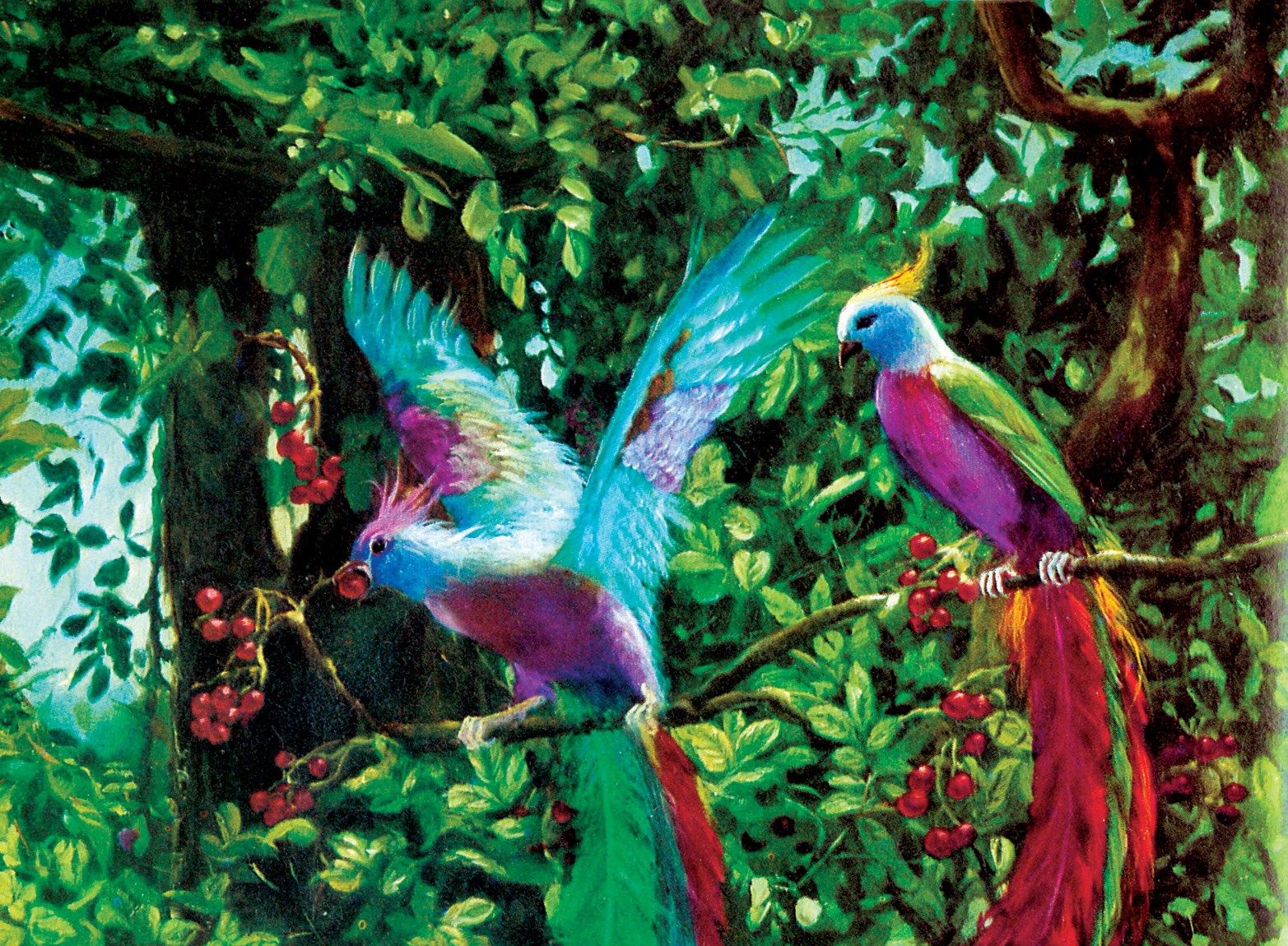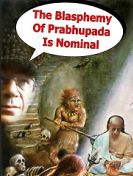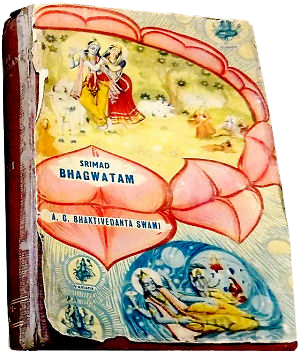TWO FRIENDLY BIRDS SITTING ON THE SAME TREE
By chance, two birds have made a nest together in the same tree. The two birds are friends and are of a similar nature. One of them, however, is eating the fruits of the tree, whereas the other, who does not eat the fruits, is in a superior position due to His potency. (SB 11.11.6)
(The two birds are the soul and the Supersoul; the jiva-atma and the param-atma, or the living entity and the supreme lord—one is the enjoyer and the other is the witness)
The example of two birds in the same tree is given to illustrate the presence within the heart of the material body of both the individual soul and the Supersoul, the Personality of Godhead. Just as a bird makes a nest in a tree, the living entity sits within the heart. The example is appropriate because the bird is always distinct from the tree. Similarly, both the individual soul and the Supersoul are distinct entities, separate from the temporary material body. The word balena indicates that the Supreme Personality of Godhead is satisfied by His own internal potency, which consists of eternality, omniscience and bliss. As indicated by the word bhūyān, or “having superior existence,” the Supreme Lord is always in a superior position, whereas the living entity is sometimes in illusion and sometimes enlightened. The word balena indicates that the Lord is never in darkness or ignorance, but is always full in His perfect, blissful consciousness.
The bird who does not eat the fruits of the tree is the Supreme Personality of Godhead, who by His omniscience perfectly understands His own position and that of the conditioned living entity, represented by the eating bird. That living entity, on the other hand, does not understand himself or the Lord. He is covered by ignorance and is thus called eternally conditioned, whereas the Personality of Godhead, being full of perfect knowledge, is eternally liberated.
Just as a bird makes a nest in a tree, the living entity sits within the heart. The example is appropriate because the bird is always distinct from the tree. Similarly, both the individual soul and the Supersoul are distinct entities, separate from the temporary material body. The word balena indicates that the Supreme Personality of Godhead is satisfied by His own internal potency, which consists of eternality, omniscience and bliss. As indicated by the word bhūyān, or “having superior existence,” the Supreme Lord is always in a superior position, whereas the living entity is sometimes in illusion and sometimes enlightened. The word balena indicates that the Lord is never in darkness or ignorance, but is always full in His perfect, blissful consciousness.
Thus, the Lord is niranna, or uninterested in the bitter fruits of material activities, whereas the ordinary conditioned soul busily consumes such bitter fruits, thinking them to be sweet. Ultimately, the fruit of all material endeavor is death, but the living entity foolishly thinks material things will bring him pleasure. The word sakhāyau, or “two friends,” is also significant. Our real friend is Lord Kṛṣṇa, who is situated within our heart. Only He knows our actual needs, and only He can give us real happiness.
Lord Kṛṣṇa is so kind that He patiently sits in the heart, trying to guide the conditioned soul back home, back to Godhead. Certainly no material friend would remain with his foolish companion for millions of years, especially if his companion were to ignore him or even curse him. But Lord Kṛṣṇa is such a faithful, loving friend that He accompanies even the most demoniac living entity and is also in the heart of the insect, pig and dog. That is because Lord Kṛṣṇa is supremely Kṛṣṇa conscious and sees every living entity as part and parcel of Himself. Every living being should give up the bitter fruits of the tree of material existence. One should turn one’s face to the Lord within the heart and revive one’s eternal loving relationship with one’s real friend, Lord Kṛṣṇa. The word sadṛśau, or “of similar nature,” indicates that both the living entity and the Personality of Godhead are conscious entities. As part and parcel of the Lord we share the Lord’s nature, but in infinitesimal quantity. Thus the Lord and the living entity are sadṛśau.
ONE SHOULD TURN ONE’S FACE TO THE LORD WITHIN THE HEART.
“The Supreme Lord is situated in everyone’s heart, O Arjuna, and is directing the wanderings of all living entities, who are seated as on a machine, made of the material energy.” (BG 18.61)
“The Supersoul fulfills the desire of the atomic soul as one friend fulfills the desire of another. The Vedas, like the Muṇḍaka Upaniṣad, as well as the Śvetāśvatara Upanisad, compare the soul and the Supersoul to two friendly birds sitting on the same tree. One of the birds (the individual atomic soul) is eating the fruit of the tree, and the other bird (Kṛṣṇa) is simply watching His friend. Of these two birds—although they are the same in quality—one is captivated by the fruits of the material tree, while the other is simply witnessing the activities of His friend. Kṛṣṇa is the witnessing bird, and Arjuna is the eating bird. Although they are friends, one is still the master and the other is the servant. Forgetfulness of this relationship by the atomic soul is the cause of one’s changing his position from one tree to another or from one body to another. The jīva soul is struggling very hard on the tree of the material body, but as soon as he agrees to accept the other bird as the supreme spiritual master—as Arjuna agreed to do by voluntary surrender unto Kṛṣṇa for instruction—the subordinate bird immediately becomes free from all lamentations. Both the Kaṭha Upaniṣad and Śvetāśvatara Upaniṣad confirm this:
samāne vṛkṣe puruṣo nimagno
‘nīśayā śocati muhyamānaḥ
juṣṭaṁ yadā paśyaty anyam īśam asya
mahimānam iti vīta-śokaḥ
‘Although the two birds are in the same tree, the eating bird is fully engrossed with anxiety and moroseness as the enjoyer of the fruits of the tree. But if in some way or other he turns his face to his friend who is the Lord and knows His glories—at once the suffering bird becomes free from all anxieties.’ Arjuna has now turned his face towards his eternal friend, Kṛṣṇa, and is understanding the Bhagavad-gītā from Him. And thus, hearing from Kṛṣṇa, he can understand the supreme glories of the Lord and be free from lamentation.” (Bhagavad-gītā As It Is 2.22, Purport)
THE ORIGINAL HOME OF THE LIVING ENTITY
The original home of the living entity and the Supreme Personality of Godhead is the spiritual world. In the spiritual world both the Lord and the living entities live together very peacefully. Since the living entity remains engaged in the service of the Lord, they both share a blissful life in the spiritual world. However, when the living entity wants to enjoy himself, he falls down into the material world. Even while he is in that position, the Lord remains with him as the Supersoul, his intimate friend. Because of his forgetfulness, the living entity does not know that the Supreme Lord is accompanying him as the Supersoul. In this way the living entity remains conditioned in each and every millennium. Although the Lord follows him as a friend, the living entity, because of forgetful material existence, does not recognize Him.
When the living entity falls down, he goes into the material world, which was created by the external energy of the Lord. This external energy is described herein as “some woman,” or prakṛti. This material world is composed of material elements, ingredients supplied by the mahat-tattva, the total material energy. The material world, created by this external energy, becomes the so-called home of the conditioned soul. Within this material world the conditioned soul accepts different apartments, or different bodily forms, and then travels about. Sometimes he travels in the higher planetary systems and sometimes in the lower systems. Sometimes he travels in higher species of life and sometimes in lower species. He has been wandering within this material universe since time immemorial. As explained by Śrī
Caitanya Mahāprabhu:
brahmāṇḍa bhramite kona bhāgyavān jīva
guru-kṛṣṇa-prasāde pāya bhakti-latā-bīja
(Cc. Madhya 19.151)
The living entity wanders into many species of life, but he is fortunate when he once again meets his friend, either in person or through His representative.
Actually, it is Kṛṣṇa who personally advises all living entities to return home, back to Godhead. Sometimes Kṛṣṇa sends His representative, who, delivering Kṛṣṇa’s very message, canvasses all living entities to return home, back to Godhead. Unfortunately the living entity is so greatly attached to material enjoyment that he does not take the instructions of Kṛṣṇa or His representative very seriously. This material tendency is mentioned in this verse as grāmya-matiḥ (sense gratification). The word mahīm means “within this material world.” All living entities within this material world are sensually inclined. Consequently they become entangled in different types of bodies and suffer the pangs of material existence.










Speak Your Mind